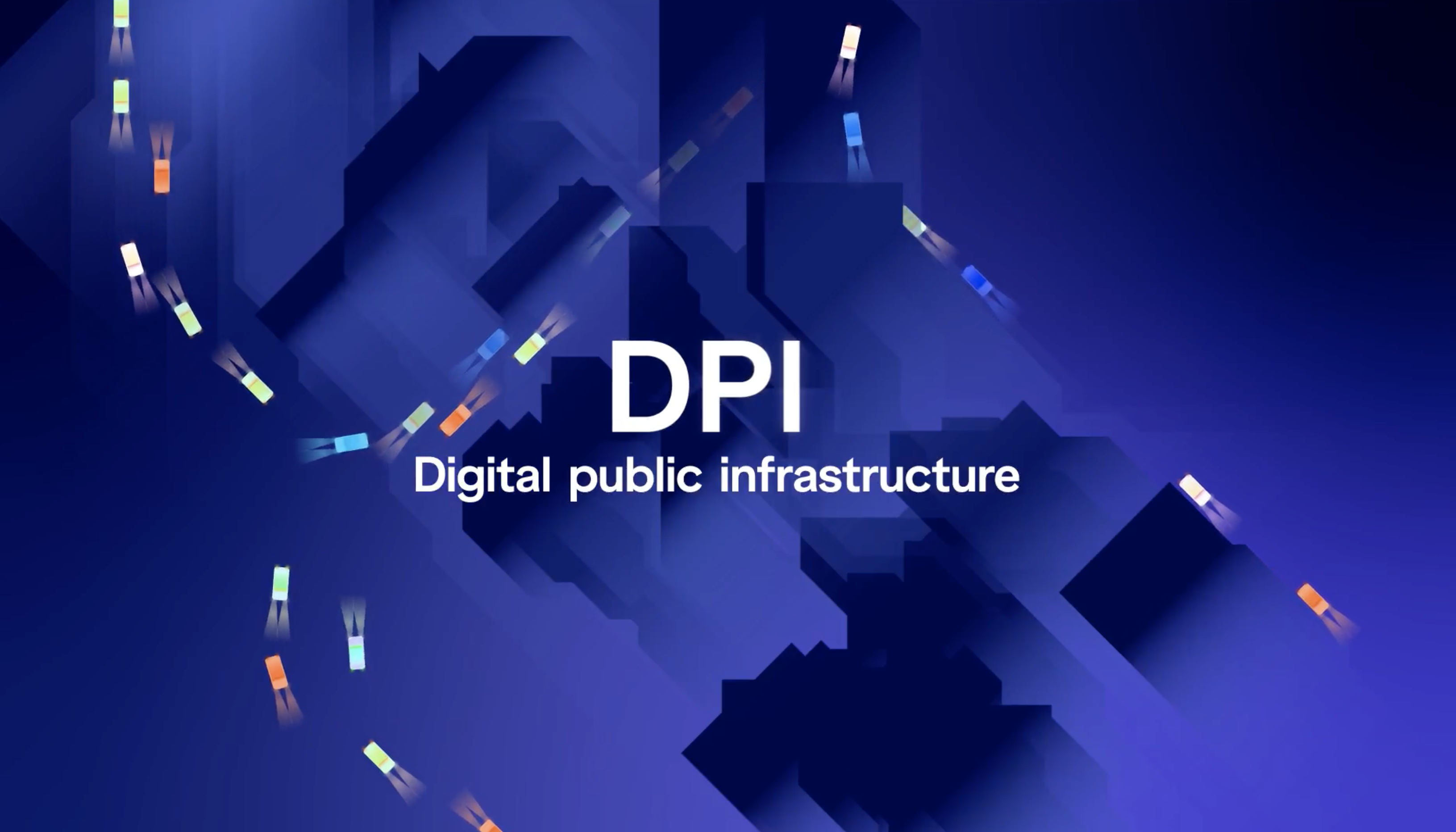As more people globally connect to the internet, governments, communities, and private sector organizations have a tremendous opportunity to harness the power of digital to improve the quality of life for all.
The potential for positive impact is vast — and game-changing — expanding access to education and healthcare, lifting individuals out of poverty, driving competitive markets and innovation, and fostering inclusion. To make this happen, however, we need to intentionally design a foundation for provisioning essential digital public and private sector services. One that builds trust, ensures everyone can use these services, and serves the best interests of all.
Enter digital public infrastructure (or DPI as it’s often referred to).
Digital public infrastructure represents the foundational digital layers necessary for powering our daily lives, just as our physical roads, railways, and bridges are crucial to a smooth-running society. But for DPI to enable a positive digital society — where it not only powers our lives but improves them — it must:
- Be designed to enable public, private, and civil society innovation. We call this serving the whole of society.
- Create a platform that connects digital services. In technology terms, this means it has to be interoperable.
- Be in service to and provide benefit to all individuals and communities. In other words, it puts people at the center.
How does digital public infrastructure help?
Good digital public infrastructure can power a wide range of services — from enabling remote workers to easily open a bank account or apply for credit online to helping cities optimize traffic flows and reduce traffic congestion so they can decrease carbon emissions.
Here are just a few examples of what this can mean.
- Increased financial inclusion. Digital public infrastructure can enable the private and public sector to more quickly and efficiently deliver solutions to expand banking, credit, and payment services to individuals who have traditionally been left behind. India’s DPI, for example, includes digital IDs (called Aadhaar) and instant payments (known as India’s United Payments Interface). Together, Aadhaar and UPI have helped India to achieve over 80% financial inclusion in 6 years — compared to the 46 years it would have taken without these foundations.
- Better healthcare. Digital public infrastructure can also help communities increase access to healthcare and improve healthcare outcomes. In Nigeria, an eHealth vaccine delivery program developed to distribute the Covid vaccine now supports the delivery of other vaccines thanks to the country’s DPI for enabling data exchange. More than 1 million children received immunizations in 2021 through this program.
- Greater gender equity. When developed with an understanding of the communities it serves, digital public infrastructure can unlock myriad services and opportunities that help improve almost every aspect of life for women. In Pakistan, DPI allows for instant payments, enabling women in rural communities for the first time to access financial services, build credit, and harness the power of the purse, laying the groundwork for social progress.
- Improved climate action. Digital public infrastructure enables the crucial data sharing needed to drive solutions that mitigate climate change, enable communities to proactively plan for adverse weather events, and allow for faster climate response when disaster occurs. For example, by facilitating the sharing of weather and climate data, DPI can enable governments to develop early warning systems and emergency response plans that help protect individuals from the impacts of extreme weather. In Mozambique, such work has helped reduce the number of people affected by cyclone-induced flooding by 82% within three years.
- Expanded economic growth and innovation. Digital public infrastructure can enable private sector organizations to innovate faster and bring wholly new services to market within communities that creates jobs, stimulates the economy, and drives competition. Research by the Omidyar Network estimates that the implementation of Open Data policies in government could add between $700 billion and $950 billion in annual income within the G20.

What are the foundations of good digital public infrastructure?
There are several often-cited foundational digital public infrastructure layers, including digital IDs, payments, data exchange, and consent networks. As our collective understanding of DPI is still evolving, we anticipate other foundational layers, such as geospatial data and address registries, may also be included as core layers.
Here is how these foundational layers can build trust and inclusion, and enable opportunities.
- Digital IDs: This layer provides individuals with a unique digital identifier that can be authenticated so they can access social services, open bank accounts, get health insurance, and more. For the more than one billion people today who don’t have any meaningful form of identification, digital IDs enable access to basic services they were previously excluded from. For those with some form of traditional ID, such as a passport or driver’s license, digital IDs can offer new levels of convenience and access to services when their paper documents have been lost. In Ukraine, digital IDs developed as part of the country’s digital transformation nearly four years ago have proved crucial to enabling Ukrainians displaced during the war to receive assistance.
- Payments: This layer powers the ability for individuals to pay bills, make purchases, and send and receive money online through any digital app or service provider, such as a utility company or government agency. With DPI, digital app and service providers can plug into an open, interoperable instant payment system so they don’t have to create bespoke connections to every card, bank network, and digital wallet. Such payment systems can accelerate the deployment of and access to new financial services across communities. For a sense of the scale of innovation possible, consider that in one month, India’s UPI supported approximately eight billion transactions worth nearly $200 billion.
- Data exchange: This layer enables data sharing across a wide range of applications and systems to streamline access to services. With data exchanges, individuals don’t have to reenter their information multiple times when, for example, applying for a loan or accessing government services. Consider Estonia’s implementation of X-ROAD. This unified and secure data exchange platform supports approximately 3,000 e-services nationwide and is estimated to save Estonians 1,345 years of working time annually. Data exchanges do this by providing a foundational architecture for how data is formatted, authenticated, logged, validated, protected, and made available to various applications and systems.
- Consent networks: This layer helps ensure the deployment of a data protection architecture and related technologies that give individuals greater control over how their personal data is used. As public and private organizations build the foundational layers for digital IDs, payments, and data exchange, developing a consent network is necessary to support individuals’ right to privacy and desire to have agency over their personal data. With consent networks, individuals can approve or reject data requests, revoke access to data, and share data at a granular level. Estonia’s X-ROAD system, for instance, uses consent networks to notify citizens every time their data is checked. Individuals can also more easily share data across apps and entities, for example, sharing relevant data with multiple lenders with the push of a button when entering an application on a loan app.
While these layers can be implemented in any order, they must be designed for interoperability so that as communities and countries add more layers to their digital public infrastructure, more opportunities become possible. For example, anyone can apply for government services online with a digital ID. When you layer digital IDs and instant payment systems together, you have the foundation to enable anyone to open a bank account or apply for a loan online.
Who builds and maintains digital public infrastructure?
Any government agency, private sector company, or foundation may develop the foundational layers for digital public infrastructure, but typically we find a mix of organizations working in partnership to do so. Sometimes these efforts are government-led, as in the case of India and Estonia. In others, it might be led by private sector organizations, such as when major credit card companies in the United States and Canada led efforts to build the foundation for instant payments.
Moreover, it’s not unusual to find different agencies or companies “owning” different layers of their country’s DPI. In India, five agencies are responsible for the various components of its DPI, called India Stack. Regardless, the government is responsible for setting rules, policies, and norms that enable and secure DPI.
Ultimately, when it comes to designing DPI, the key isn’t who takes the lead – it’s using open standards and modular designs to maximize inclusion and competition for the public good.
What safeguards must be considered?
As with any technology, there is potential for the foundational layers that comprise digital public infrastructure to be misused. Data systems can create a “honey pot” of information that bad actors can target to steal identities and commit fraud. Governments intent on repressing or excluding groups could use digital IDs, payment systems, and data exchanges to accelerate illegal surveillance or targeted persecution.
As a result, it’s imperative when implementing DPI to build checks and balances that provide accountability and help ensure it continues to serve the public good. Some approaches include:
- Technical safeguards, such as employing decentralized data storage to make it more difficult for non-state actors, rogue government actors, or authoritarian regimes to gain access to or steal personal data.
- Policies and regulations, including laws protecting data and implementing cybersecurity standards. As India’s government developed its digital identity system, India’s Supreme Court made several rulings to protect individuals’ privacy rights.
- Community outreach, participation and agency, to actively combat any in-built or resultant exclusion or marginalization. Governments and policymakers must work closely with important bodies, such as civil society groups, throughout the DPI process.
- Oversight and accountability mechanisms, with robust, well-resourced institutions, such as data protection agencies or independent bodies, for enforcing the rules while also offering citizens responsive and effective redress.
With robust checks and balances in place across these four areas, DPI can help build a positive digital future.
How can I learn more?
The Digital Impact Alliance has numerous resources to help governments, communities, and private sector organizations get started.
- Dive into our research and publications on digital public infrastructure, including best practices, insights, recommendations, and case studies.
- Peruse our Digital Impact Exchange, which provides public and private organizations with a good starting point to explore the products, tools and strategies they’ll need to build digital IDs, payment systems, data exchanges, and consent networks.
- And join GovStack, a partnership of governments, agencies, private sector organizations, and the open source community working together to build sustainable digital public infrastructure and help governments create human-centered digital services that empower individuals, improve well-being, and build more inclusive and resilient societies.






